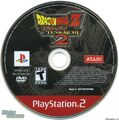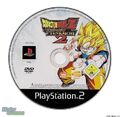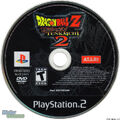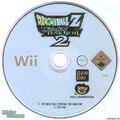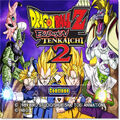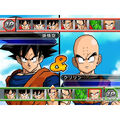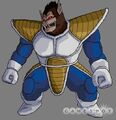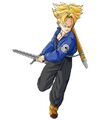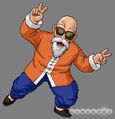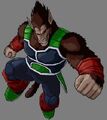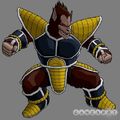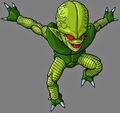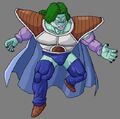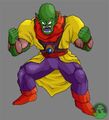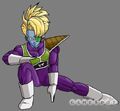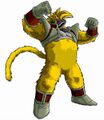Dragon Ball Z: Budokai Tenkaichi 2, known as Dragon Ball Z: Sparking! NEO (ドラゴンボールZ Sparking! NEO Doragon Bōru Zetto Supākingu! Neo) in Japan, is a fighting game released on the PlayStation 2 and on the Wii. It is the sequel to Dragon Ball Z: Budokai Tenkaichi.
The Wii version was confirmed as being a launch title in the US for November 19, 2006, in an IGN interview with Atari[1] though some stores in the US started selling the Wii version on November 15, 2006. A V-Jump issue listed January 2007 as the release date for the Japanese version of the Wii release with an additional six characters, and an extra stage. The game was released in Europe on March 30, 2007, but was delayed in Australia until April 5, 2007. Both the European and Australian versions have the extra features of the Japanese Wii version. Its sequel is Dragon Ball Z: Budokai Tenkaichi 3.
Gameplay[]
There are 129 playable characters in most versions of the game and 135 in the Japanese and PAL Wii versions. All characters featured in the previous game are available in this game as well. Battles can now involve up to ten characters fighting one at a time on the battlefield, with one teammate coming in after the other has been knocked out or when the player wishes to switch to another fighter. This is referring to Free Battle options.
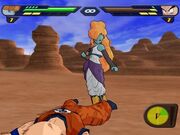
Zangya beats Krillin
Most versions of the game have 16 large arenas (11 of which are taken from the previous Budokai Tenkaichi game). The Japanese and PAL Wii versions have 17 with the inclusion of a new space level, and 9 game modes. The game also features in game transformations, in addition to being able to choose to play in a transformed state from the start. In order to transform, R3 (1 on Wii) and Left/Up/Right must be pressed to select the form wanted. One may also press Down + R3 (Down + 1) to revert to their original state (Only transformations that have shown that they can be undone in the anime can do this). Fusions can be performed in-battle as well, and it is performed the same way as tag teams and transformations except that L2 (Z) has to be pressed. Fusion can only be done in Tag battles and Free battles, and the player must have the suitable character as a Tag partner; for example, base Goku and Vegeta (second form) to form Vegito. If that fused character has a second or third form, R3 + L2 + Up (Z + 1 + Up) or Right can be pressed to transform into that different form. Also, unlike the Budokai series, the fusions do not end after ki drain, or fatigue, or time limit. A customizer has been made to change the characters. The Dueling Mode features a 'Battle Settings' option, where can be adjusted the dueling time, COM difficulty level, and set the In-Game Transformations on or off during gameplay.
Controls[]
The Wii version of the game features a unique control scheme using the system's remote controller. Using the motion sensing controller, players are able to control their fighters by carrying a remote/nunchuk combo and mimicking moves from the series, an example being the Kamehameha or Galick Gun. Players are able to choose whether they wish to use the Wii Remote and Nunchuk, the Wii Classic Controller, or a GameCube controller.[2]
Game Modes[]
Dragon Adventure[]
This is the main mode of the game. It is similar to the Dragon Universe mode of Dragon Ball Z: Budokai 3: the player uses a character around Earth and Namek looking for Dragon Balls, skill capsules and opponents. This mode covers Dragon Ball Z to Dragon Ball GT, and also includes the movie stories The Tree of Might, Lord Slug, Cooler's Revenge, The Return of Cooler, Super Android 13!, Broly - The Legendary Super Saiyan, Bojack Unbound, Broly - Second Coming, Fusion Reborn, and Wrath of the Dragon as well as the TV special stories Bardock - The Father of Goku and The History of Trunks. The outcome of the battles in the mode changes the course of the story. New powers, characters, and "what-if" stories are unlocked in this mode.
Ultimate Battle Z[]
This mode uses a system where the player selects a type of battle and progresses up a pillar that is similar to the Mortal Kombat system. Each pillar has a specific theme and condition. By beating a pillar, the player earns a score, items, and more pillars.
Dragon Tournament[]
Similar to the same mode in the Budokai series, the player can enter a world tournament and try to win their way to the top. There are three levels of the basic tournament and a Cell Games mode (which is hosted by Cell). Since characters can fly, characters can leave the perimeter of the arena, but will be called for ring-out if they touch the ground. There are no restrictions to the Cell Games mode, but the last match of the Cell Games mode is always against Perfect Cell. Since there is no money awarded in this game, the prize for winning a World Tournament is a Z-item. The World Tournament mode can be played with several entrants, but if there is more than one human player, then no prize will be awarded.
Dragon Library[]
This is an encyclopedia that consists of character biographies and character models. It also has a brief history on the story of the series as well as a sound select menu where you can hear the music in the game.
Playable characters[]
Returning characters[]
| Name | Returning Transformations | New Transformations | Available at Start |
|---|---|---|---|
| Android #16 | Yes | ||
| Android #17 | Yes | ||
| Android #18 | Yes | ||
| Android #19 | Yes | ||
| Baby Vegeta | No | ||
| Bardock |
|
No | |
| Bojack |
|
No | |
| Broly |
|
No | |
| Burter | No | ||
| Cell |
|
No | |
| Cell Jr. | No | ||
| Chiaotzu | Yes | ||
| Cooler |
|
No | |
| Demon King Dabura | No | ||
| Dodoria | Yes | ||
| Dr. Gero | No | ||
| Frieza |
|
Yes | |
| General Tao | No | ||
| Ginyu | No | ||
| Gogeta | No | ||
| Gohan |
|
Yes | |
| Goku | Yes | ||
| Goku | No | ||
| Goten |
|
Yes | |
| Gotenks | No | ||
| Guldo | No | ||
| Hercule | No | ||
| Janemba |
|
|
No |
| Jeice | No | ||
| Kid Buu | No | ||
| Kid Gohan | Yes | ||
| Kid Goku |
|
No | |
| Kid Trunks |
|
Yes | |
| Krillin | Yes | ||
| Majin Buu | Yes | ||
| Majin Buu (Pure Evil) | No | ||
| Master Roshi |
|
No | |
| Mecha-Frieza | No | ||
| Nappa |
|
Yes | |
| Piccolo | Yes | ||
| Raditz |
|
Yes | |
| Recoome | No | ||
| Saibaman | Yes | ||
| Super 17 | No | ||
| Super Buu |
|
No | |
| Teen Gohan | Yes | ||
| Tien | Yes | ||
| Trunks (Sword) |
|
Yes | |
| Trunks |
|
Yes | |
| Ultimate Gohan | No | ||
| Vegeta |
|
No | |
| Vegeta (second form) | No | ||
| Vegeta (second form) | No | ||
| Vegeta (second form) | No | ||
| Vegeta (Scouter) |
|
Yes | |
| Vegito |
|
No | |
| Videl |
|
|
No |
| Yamcha | Yes | ||
| Zarbon |
|
Yes |
New characters[]
| Name | Transformations | Available at Start |
|---|---|---|
| Android #13 |
|
No |
| Cui | No | |
| Garlic Jr. |
|
No |
| Grandpa Gohan | No | |
| Hirudegarn | No | |
| Meta-Cooler | No | |
| Pan | No | |
| Pikkon | No | |
| Salza | No | |
| Slug |
|
No |
| Supreme Kai |
|
No |
| Syn Shenron |
|
No |
| Tapion | No | |
| Turles |
|
No |
| Uub |
|
No |
| Yajirobe | No | |
| Zangya | No |
Wii Exclusive characters[]
| Name | Transformations | Available at Start |
|---|---|---|
| Appule | No | |
| Cyborg Tao | No | |
| Frieza Soldier | No | |
| Demon King Piccolo | No | |
| Pilaf Machine |
|
No |
Battle Stages[]
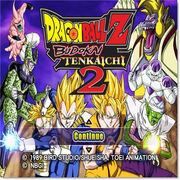
Main Menu
- Wasteland
- Space
- Rocky Area
- Namek
- Dying Namek
- Planet
- Mountain Road
- Kami's Lookout
- Room of Spirit and Time
- Kame House
- Islands
- Glacier
- Cell Games Arena
- World Tournament Stage
- Supreme Kai's World
- City (Ruins)
- Ruined Earth
Voice cast[]
Reception[]
| Publication | Score | |
|---|---|---|
| PS2 Version | ||
| VG Resource Center | 7.5 of 10[3] | |
| IGN | 8.3 of 10[4] | |
| 1UP | 8 of 10[5] | |
| Yahoo! Games | 3.5 of 5[6] | |
| GameZone | 8.1 of 10[7] | |
| GameSpot | 6.5 of 10[8] | |
| Wii Version | ||
| IGN | 8.3 of 10[9] | |
| Game Trailers | 8 of 10[10] | |
| Review compilations (PS2 Version) | ||
| Game Rankings | 76.3% (based on 40 reviews)[11] | |
| Metacritic | 78% (based on 16 reviews)[12] | |
| Review compilations (Wii Version) | ||
| Game Rankings | 71.9% (based on 32 reviews)[13] | |
| Metacritic | 76% (based on 7 reviews)[14] | |
Critical reaction has been positive. Numerous reviews praised the game's high fighter count and detailed cel-shaded graphics, as well as the high amount of fan-service to DBZ fans. Some people, however, have taken issue with the game's complex controls. Mark Bozon at IGN said "The sheer speed and complexity of the controls may turn some people off, but the general combat will eventually come down to two buttons, making the game amazingly easy to learn, but nearly impossible to fully master." Many have said that the game is a "DBZ fan's wet dream," with VGRC.net stating "non-DBZ fighting game fans might even want to give it a spin as well." The game received the 'Best Fighting Game of the Year' award from X-Play, which is surprising since most Dragon Ball Z games are rated from mediocre to poor in their ranking system; the only notable exception is Dragon Ball Z: Budokai 3, which received a four out of five. This game also received a four out of five from X-Play.
The game became Namco Bandai's top-selling game of 2006, selling 1.18 million copies worldwide in its first six months.[15] In Japan the game sold 423,000 copies on PS2 by the end of 2006[16] and 166,000 copies on Wii by the end of 2007.[17]
Trivia[]
- Unlike its predecessor, Budokai Tenkaichi, this game refers to Bulla by her correct English name.
- While Jeice will say "Don't play stupid with me, wanker!" sometimes before a battle in Budokai Tenkaichi, the "wanker" section of the sentence is cut out of this game and Budokai Tenkaichi 3, possibly because the word "wanker" is vulgar slang in the United Kingdom, but the "w" can clearly be heard spoken after he says, "Don't play stupid with me!"
- During one scene in the What-If saga Beautiful Treachery, the English narrator says "Suddenly, Goku vanished. Krillin had used the Dragon Balls to teleport him back to Earth", but the text box incorrectly says "Right after, Goku disappeared. Actually, Krillin had asked Shenron for Instant Transmission."
- In the What-If saga Destined Rivals, Hercule fights 18 just like he does in the final round of the tournament in the anime, except in this What-If story, the tournament proceeds as planned.
- This is the first game to include filler characters, such as Pikkon and Garlic Jr. However, both appear in movies, and are placed with the movie characters (though Garlic Jr.'s role in the game is that of the anime).
- Full 3D models of Korin, Fortuneteller Baba, Dende, Babidi, and Old Kai appear in the Adventure mode.
- Though the names of all the characters are spelled using anime character names on the character selection screen, some text boxes use Vegito's manga name "Vegetto".
- On the Wii version, the game case says that you can only play with the Wii Remote and the Nunchuck, or the Classic Controller. In the game, you can play with the Wii Remote and the Nunchuck, the Classic Controller, or the GameCube Controller.
- When in tournaments, Supreme Kai's and Kibitoshin's names in the text box appearing just before and after battle read "Shin", the identity the former enters the 25th World Tournament under.
- For comical relief, the Dragon Ball GT part of Adventure mode ended with Goku (as an adult) deciding to have lunch and Vegeta mentioning his annoying behavior as if nothing happened.
- If Zangya is matched with Android 18, Zangya will say "Your man is kinda cute" to which Android 18 responds by calling Zangya a "skank." This was removed in Budokai Tenkaichi 3, probably because of its vulgarity as well.
- If Super Saiyan 3 Gotenks is tagged out in a tag battle, he will say "Peanut-butter jelly time!" as a reference to the popular internet meme.
- If Zangya beats Krillin or Master Roshi, she says "Don't cha wish your girlfriend was tough like me? Don't cha?" based on the song by the Pussycat Dolls and Busta Rhymes.
- When Goku faces Kid Goku, he says Kid Goku looks like him when he was younger, thinking Kid Goku is a completely different person. Kid Goku replies by telling Goku that he looks a lot like him.
- Early videos of this game showed health bars identical to those of Budokai Tenkaichi and Goku being able to transform into Super Saiyan 4. However, the health bar was changed and Super Saiyan 4 Goku was made a separate character before the game's release.
- In a video showing the beta version, the life bars and the Ki meters looked like those from Budokai Tenkaichi (as mentioned above), and it used Budokai OST by Kenji Yamamoto. Also, Lord Slug used Piccolo's voice (possibly a placeholder).
- Also, Vegeta from the Buu Saga is seen transforming into Majin Vegeta but in the final version, Majin Vegeta is a separate character.
- For some reason Kazuyuki Sogabe didn't voice Android #13 before his death in this game (just like Kōhei Miyauchi in Dragon Ball Z: Ultimate Battle 22 and Dragon Ball Z: Shin Butōden as Master Roshi), the reason for this is because Sogabe lost his voice and quit voice acting in 2000 (Although he returned in 2005).
- The USA version of this game uses Future Trunks from Dragon Ball Z: Ultimate Battle 22's intro as a cover, reason of it is unknown.
- The Dragon Library erroneously states that Josh Martin voiced Super Buu and Justin Cook voiced Majin Buu (Pure Evil).
- Korin is written as "Karin" (his original Japanese name) in the English voice cast credits.
- Great Ape Vegeta's ultimate is incorrectly called "Super Garlic Gun" rather than "Super Galick Gun.".
- This also applies to Great Ape Baby.
Gallery[]
Scans & screenshots[]
Characters[]
References[]
- ↑ IGN interview with Atari. IGN.
- ↑ "Dragon Ball Z: Tenkaichi 2 Hands-on" at ign.com
- ↑ VGRC review of DBZ Budokai Tenkaichi 2 (PS2). URL retrieved 2 December 2006.
- ↑ IGN review of DBZ Budokai Tenkaichi 2 (PS2). URL retrieved 2 December 2006.
- ↑ 1UP review of DBZ Budokai Tenkaichi 2 (PS2). URL retrieved 2 December 2006.
- ↑ Yahoo! Games review of DBZ Budokai Tenkaichi 2 (PS2). URL retrieved 2 December 2006.
- ↑ GameZone review of DBZ Budokai Tenkaichi 2 (PS2). URL retrieved 2 December 2006.
- ↑ Gamespot review of DBZ Budokai Tenkaichi 2 (PS2). URL retrieved 6 December 2006.
- ↑ IGN review of DBZ Budokai Tenkaichi 2 (Wii). URL retrieved 2 December 2006.
- ↑ Game Trailers review of DBZ Budokai Tenkaichi 2 (Wii). URL retrieved 15 November 2006.
- ↑ GameRankings.com page for DBZ Budokai Tenkaichi 2 (PS2). URL retrieved 2 December 2006.
- ↑ Metacritic on DBZ Budokai Tenkaichi 2 (PS2). URL accessed 2 December 2006.
- ↑ GameRankings.com page for DBZ Budokai Tenkaichi 2 (Wii). URL retrieved December 2, 2006.
- ↑ Metacritic on DBZ Budokai Tenkaichi 2 (PS2). URL accessed 2 December 2006.
- ↑ Namco Bandai annual profit up 71 percent, gamespot.com
- ↑ Famitsu 2006 video game sales
- ↑ Famitsu 2007 video game sales
External links[]
- Official Website
- Official Atari Website (Wii Version)
- Official Atari US Dragon Ball Z: Budokai Tenkaichi 2 forum
- Dragon Ball Z: Budokai Tenkaichi 2 at IGN (Wii version)











